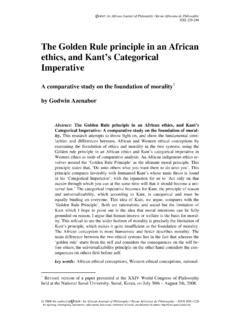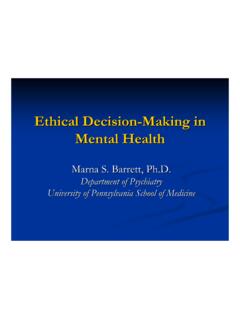Transcription of Ethical Decision Making and Action
1 3 EthicalDecision Makingand ActionChapter PreviewComponents of Ethical BehaviorComponent 1: Moral Sensitivity (Recognition)Component 2: Moral JudgmentComponent 3: Moral MotivationComponent 4: Moral CharacterDecision- Making FormatsKidder s Ethical CheckpointsThe Moral CompassThe Five I FormatImplicationsApplication ProjectsChapter End Case: Scenarios for AnalysisEndnotesIn Making and implementing decisions, we put widely accepted Ethical prin-ciples, as well our vocation, values, character and spiritual resources, intopractice. This chapter focuses both on the how (processes) and the how to (for-mats) of moral thinking and Action . Our chances of coming up with a sound,well-reasoned conclusion and executing our plan are greater if we understandhow Ethical decisions are made and take a systematic approach to (Ethics) 10/25/2006 3:52 PM Page 59 Components of Ethical BehaviorBreaking the process down into its component parts enhances understandingof Ethical Decision - Making and behavior.
2 Moral psychologist James Rest iden-tifies four elements of Ethical Action . Rest developed his Four-ComponentModel by asking: What must happen psychologically in order for moralbehavior to take place? He concluded that Ethical Action is the product ofthese psychological subprocesses: (1) moral sensitivity (recognition); (2) moraljudgment or reasoning; (3) moral motivation; and (4) moral first half of the chapter is organized around Rest s framework. I ll describeeach factor and then offer some tips for improving your performance on thatelement of Rest s 1: MORAL SENSITIVITY (RECOGNITION)Moral sensitivity is the recognition that an Ethical problem exists.
3 Suchrecognition requires being aware of how our behavior impacts others, identi-fying possible courses of Action , and determining the consequences of eachpotential strategy. Moral sensitivity is key to transformational ethics. We can tsolve a moral dilemma unless we know that one is and perspective skills are essential to identifying and exploringmoral issues. Understanding how others might feel or react can alert us to thepotential negative effects of our choices and makes it easier to predict the likelyoutcomes of various options. For example, the central figure in the Is It Betterto Ask for Permission or to Ask for Forgiveness? Chapter End Case empathizeswith neighborhood residents and understands their point of view.
4 As a result,he realizes that he faces an Ethical to University of Virginia ethics professor Patricia Werhane, manysmart, well-meaning managers stumble because they are victims of ways of thinking or mental models don t include important eth-ical considerations. In other words, they lack moral imagination. Take the caseof the Nestl Company. The European food producer makes a very high qual-ity infant formula, which the firm successfully marketed in North America,Europe, and Asia. It seemed to make sense for the company to market formulain East Africa using the same communication strategies that had worked else-where. However, Nestl officials failed to take into account important culturaldifferences.
5 Many East African mothers could not read label directions, were sopoor that to make the product last longer they overdiluted it, and used pollutedwater to mix it. In a society that honors medicine men, parents felt pressuredto use formula because it was advertised with pictures of men in white a result, many poor African mothers wasted money on formula when they60 TRANSFORMING INDIVIDUAL ETHICS IN THE ORGANIZATION03-Johnson(Ethics) 10/25/2006 3:52 PM Page 60could have breast-fed their children for free. Thousands of their babies diedafter drinking formula mixed with polluted water. Nestl refused to stop itsmarketing campaign despite pressure from the World Health Organization andonly quit after being faced with a major boycott.
6 Company leaders didn t con-sider the possible dangers of marketing to third world mothers and failedto recognize that they were engaged in unethical exercise moral imagination, managers and employees step outside theircurrent frame of reference (disengage themselves) to assess a situation andevaluate options. They then generate creative solutions. Werhane usesChicago s South Shore Bank as an example of moral imagination at work. Inthe early 1970s, a group of investors bought a failing bank in the impoverishedSouth Shore neighborhood and began loaning money for residential restora-tion. Few people in the area qualified for traditional bank loans, so South Shoremanagers developed a new set of criteria.
7 Loan officers gave credit to individ-uals of limited means who had good reputations. The bank prospered and,at the same time, the neighborhood became a desirable place to live. SouthShore s morally imaginative owners and managers envisioned a profitablefinancial institution in a depressed, poverty stricken area. They disproved tra-ditional bank logic by demonstrating that they could make money in aresponsible manner under tough muteness, like lack of moral imagination, interferes with the recog-nition of moral issues. Managers can be reluctant to talk about their actions inethical terms. They may want to avoid controversy or believe that keepingsilent will help them appear practical, efficient, powerful, and capable of han-dling their own a situation in moral terms breaks thisethical code of silence.
8 Such terms as values, justice, immoral, character, right,and wrongencourage listeners to frame an event as an Ethical problem and toengage in moral for Enhancing Your Ethical SensitivityEngage in active listening and best way to learn about thepotential Ethical consequences of choices, as well as the likely response ofothers, is through listening closely to what others have to say. (See Chapter 4for a closer look at the process of active listening.) Role-play can also fosterunderstanding. Taking the part of another individual or group can provide youwith important insight into how the other party is likely to mental models or the dangers of your currentmental models and try to visualize other perspectives.
9 Distance yourself froma situation to determine if it does indeed have moral implications. Rememberthat you have Ethical duties that extend beyond your group or Decision Making and Action 6103-Johnson(Ethics) 10/25/2006 3:52 PM Page 61Be for innovative ways to define and to respond to Ethical dilem-mas; visualize creative opportunities and t hesitate to discuss problems and your decisions using ethicalterms. Doing so will help frame an argument as an Ethical one for you and 2: MORAL JUDGMENTA fter determining there is an Ethical problem, Decision makers thenchoose among the courses of Action identified in Component 1. They makejudgments about what is the right or wrong thing to do in this specific judgment has been studied more than any other element of the Restmodel.
10 There is far too much information to summarize it here. Instead, I llfocus on two topics that are particularly important to understanding howproblem solvers determine whether a solution is right or wrong cognitivemoral development and defective Moral DevelopmentBefore his death, Harvard psychologist Lawrence Kohlberg was the leadingchampion of the idea that individuals progress through a series of moral stages justas they do physical stage is more advanced than the one before. As indi-viduals develop, their reasoning becomes more sophisticated. They become lessself-centered and develop broader definitions of morality (see Box ).Box Stages of Moral Development62 TRANSFORMING INDIVIDUAL ETHICS IN THE ORGANIZATIONR easons for Doing RightAvoidance ofpunishment; thesuperior power Is RightTo avoid breaking rulesbacked by punishment,obedience for its ownsake, and to avoidphysical damage topersons and and StageLEVEL I PRE-CONVENTIONALS tage 1 HeteronomousMoralityContent of Stage03-Johnson(Ethics) 10/25/2006 3:52 PM Page 62 Ethical Decision Making and Action 63To serve your own needsor interests in a worldwhere you have torecognize that otherpeople have their interests, need to be a goodperson in your own eyesand those of others.











